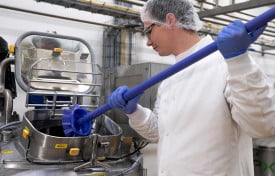Safety & Personnel

- April 23, 2014
Decibels (db) are a measurement of environmental noise. This chart from the United States Department of Labor showcases a spectrum of sounds and their decibel levels.
When looking into hearing protection devices, you will see the acronym: "NRR." The noise reduction rating (NRR) refers to the amount of sound (dB) reduction a hearing protection device provides when worn properly.
The higher the NRR number, the more hearing protection. For example, a pair of NRR: 30 rated earplugs would provide more auditory protection than a NRR: 27 rated pair of earplugs.
OSHA standards require the use of ear protection for employees that are exposed to noise at or above 85 dB for an 8 hour weighted average.
- January 22, 2014
What are your top safety concerns at your operation? Do you have short-term or long-term goals in mind when it comes to your safety program? Well, if you do, you may want to consider the following.
The U.S. Occupational Safety & Health Administration (OSHA) has released figures for their “Top 10” violations list in 2013 (most frequently issued citations for fiscal 2013, ending Sept. 30.):
"1926.501 — Fall Protection 8,241 total violations
1910.1200 — Hazard Communication 6,156 total violations
1926.451 — Scaffolding 5,423 total violations
1910.134 — Respiratory Protection 3,879 total violations
1910.305 — Electrical, Wiring Methods 3,452 total violations
1910.178
- November 07, 2012
From school labs to medical labs to QA/QC labs in places like the food industry, eye protection is a safety concern that receives a lot of attention. Rightly so, as every day in the United States, about 2000 workers are treated medically for an eye injury. In addition, eye injuries "alone cost more than $300 million per year in lost production time, medical expenses, and worker compensation." The proper use of goggles and safety glasses can make a significant difference in lowering these numbers.
One can browse through countless policy manuals for schools, government agencies, and some industrial settings, where eye protection is mandated. With such universal attention paid to eye safety, why do the numbers of injuries and costs remain so high? The answer isn't a simple one, but some factors can include the following: compliance and standards issues, user error, or simply put: momentary indifference.
Compliance and standards issues involve many possibly enabling factors for eye injuries in the lab. A lack of employee training can factor in, as can a lack of knowledge of federal and state standards. For instance, an employee may not understand that their daily glasses do not provide sufficient protection. Contact users and glasses-wearers need to have additional eye protection, such as goggles that fit around the glasses, or have their prescription incorporated into an ANSI Z87.1 compliant design. These issues may seem quite obvious to some operations, but these causes for concern continue to occur in the lab. To learn more or to refresh your knowledge on eye protection in the workplace click here.
In terms of accidents in the lab, user error is another factor that can come into play. Employees need to ensure that their eye protection is Z87 compliant. Further, they need to know what kinds of hazards exist, and to select the proper eyewear for those hazards. Finally, the eyewear must be properly fitted. For some helpful information on hazards and choosing the proper eyewear for the job, click here.
- October 14, 2010
Most food processing facilities these days have metal detection equipment in place. It is designed to detect contaminants from a variety of sources and prevent them from entering the finished food product. Current hazard analysis critical control point (HACCP) programs place emphasis on assuring that no contaminants reach the end user. There are numerous contaminants that can be detected by metal detectors, but one that most people wouldn’t think of is disposable gloves.
Disposable gloves are used in food processing facilities every day, and the risk of a piece tearing off or even an entire glove getting into the product can be a major concern. There are no detectors for your average vinyl, nitrile or even latex gloves when they are used in food processing facilities and get into the product. One way of combating the risk of harming your product and in turn losing both time and money is to use metal detectable gloves, along with some sort of metal detection equipment that your product goes through.
- May 27, 2010
The American National Standards Institute (ANSI) revised the standard relating to first aid kits in the workplace. ANSI Z308.1-2003 has been replaced by ANSI Z308.1-2009. There are a few changes that our customers should pay attention to. The old standard listed eight items that were required as minimum fill for workplace first aid kits. The new standard brings the required item total to ten. The other notable change is that latex is to be eliminated from first aid altogether.
The new required items are:
(1) First Aid Guide
(1) Absorbent Compress 4″ X 8″ minimum
(16) 1″ X 3″ Adhesive Bandages
(1) Adhesive Tape 2.5 yard roll
(10) Antiseptic Treatment Applications 0.9 Gram each
(6) Burn Treatment Applications 0.9 Gram each
(4) 3″ X 3″ Sterile Gauze Pads
(2) Pair Medical Exam Gloves
(1) Triangular Bandage 40″ X 40″ X 56″ min
(6) Antibiotic Ointment Applications 0.5 Gram each.There are also now ten items listed as Recommended Supplies.






